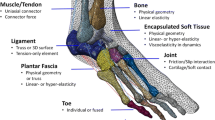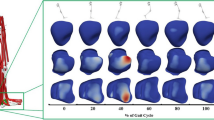Abstract
The aim of this work is to provide a computational tool for the investigation of ankle mechanics under different loading conditions. The attention is focused on the biomechanical role of ankle ligaments that are fundamental for joints stability. A finite element model of the human foot is developed starting from Computed Tomography and Magnetic Resonance Imaging, using particular attention to the definition of ankle ligaments. A refined fiber-reinforced visco-hyperelastic constitutive model is assumed to characterize the mechanical response of ligaments. Numerical analyses that interpret anterior drawer and the talar tilt tests reported in literature are performed. The numerical results are in agreement with the range of values obtained by experimental tests confirming the accuracy of the procedure adopted. The increase of the ankle range of motion after some ligaments rupture is also evaluated, leading to the capability of the numerical models to interpret the damage conditions. The developed computational model provides a tool for the investigation of foot and ankle functionality in terms of stress–strain of the tissues and in terms of ankle motion, considering different types of damage to ankle ligaments.




Similar content being viewed by others
References
Shin J, Yue N, Untaroiu CD (2012) A finite element model of the foot and ankle for automotive impact applications. Ann Biomed Eng 40(12):2519–2531
Scott AL (2002) Assessment of the injured ankle in the athlete. J Athl Train 37(4):406–412
Corazza F, O’ Connor JJ, Leardini A, Castelli VP (2003) Ligament fibre recruitment and forces for the anterior drawer test at the human ankle joint. J Biomech 36:363–372
Rosenbaum D, Becker HP, Wilke HJ, Claes LE (1998) Tenodeses destroy the kinematic coupling of the ankle joint complex. A three dimensional in vitro analysis of joint movement. J Bone Jt Surg Br 80(1):162–168
Kovaleski JE, Gurchiek LR, Heitman RJ, Hollis JM, Pearsall AW (1999) Instrumented measurement of anterior-posterior and inversion-eversion laxity of the normal ankle joint complex. Foot Ankle Int 20:808–814
Kovaleski JE, Hollis MJ, Norrell PM, Vicory JR, Heitman RJ (2004) Sex and competitive status in ankle inversion-eversion range of motion of college students. Percept Mot Skills 99:1257–1262
Lapointe SJ, Siegler S, Hillstrom H, Nobilini RR, Mlodzienski A, Techner L (1997) Changes in the flexibility characteristics of the ankle complex due to damage to the lateral collateral ligaments: an in vitro and in vivo study. J Orthop Res 15:331–341
Prisk VR, Imhauser CW, O’Loughlin PF, Kennedy JG (2010) Lateral ligament repair and reconstruction restore neither contact mechanics of the ankle joint nor motion patterns of the hindfoot. J Bone Jt Surg Am 92 (14):2375–2386.
Siegler S, Chen J, Schneck AD (1988) The three-dimensional kinematics and flexibility characteristics of the human ankle and subtalar joints – Part I: kinematics. J Biomech Eng 110:364–373
Ringleb SI, Dhakal A, Anderson CD, Bawab S, Paranjape R (2011) Effects of lateral ligament sectioning on the stability of the ankle and subtalar joint. J Orthop Res 29:1459–1464
Kovaleski JE, Hollis JM, Heitman RJ, Gurchiek LR, Pearsall AW (2002) Assessment of ankle-subtalar joint complex laxity using an instrumented ankle arthrometer: an experimental cadaveric investigation. J Athl Train 37(4):467–474
Schwarz NA, Kovaleski JE, Heitman RJ, Gurchiek LR, Gubler-Hanna C (2011) Arthrometric measurement of ankle complex motion: normative values. J Athl Train 46(2):126–132
Hubbard TJ (2008) Ligament laxity following inversion injury with and without chronic ankle instability. Foot Ankle Int 29(3):305–311
Hubbard TJ, Kramer LC, Denegar CR, Hertel J (2007) Contributing factors to chronic ankle instability. Foot Ankle Int 28(3):343–354
Hubbard TJ, Kaminski TW, Vander Griend RA, Kovaleski JE (2004) Quantitative assessment of mechanical laxity in the functionally unstable ankle. Med Sci Sports Exerc 36(5):760–766
Vassenon T, Gao Y, Phisitkul P (2012) Comparison of two manual tests for ankle laxity due to rupture of the lateral ankle ligaments. Iowa Orthop J 32:9–16
Docherty CL, Rybak-Webb K (2009) Reliability of the anterior drawer and talar tilt tests using the LigMaster joint anthrometer. J Sport Rehabil 18:1–9
Disanto TJ, Swanik B, Swanik KA, Straub SJ, Needle AR (2011) Concurrent validity of the anterior drawer test and an arthrometer in evaluating ankle laxity. Athl Train Sports Healthy Care 3:15–20
Pearsall AW, Kovaleski JE, Heitman RJ, Gurchiek LR, Hollis JM (2006) The relationships between instrumented measurements of ankle and knee ligamentous laxity and generalized joint laxity. J Sports Med Phys Fit 46(1):104–110
McKeon PO, Paolini G, Ingersoll CD, Kerrigan DC, Saliba EN, Bennettl BC, Hertel J (2009) Effects of balance training on gait parameters in patients with chronic ankle instability: a randomized controlled trial. Clin Rehabil 23(7):609–621
Wilkerson GB, Kovaleski JE, Meyer M, Stawiz C (2005) Effects of the subtalar sling ankle taping technique on combined talocrural-subtalar joint motions. Foot Ankle Int 26(3):239–246
Choe JR, Park SB, Ryu SH, Kim SH, Lee SB (2009) Landing impact analysis of sports shoes using 3-D coupled foot-shoe finite element model. J Mech Sci Technol 23:2583–2591
Shin J, Yue N, Untaroiu CD (2013) Biomechanical and injury response of human foot and ankle under complex loading. J Biomech Eng 135:101008
Cheung JTM, Nigg BM (2007) Clinical applications of computational simulation of foot and ankle. Sport Orthop Traumatol 23:264–271
Cheung JTM, Zhang M, Leung AKL, Fan YB (2005) Three-dimensional finite element analysis of the foot during standing—a material sensitivity study. J Biomech 71:1045–1054
Wang KTD, Wang C, Wang X, Liu A, Nester CJ, Howard D (2009) An in vivo experimental validation of a computational model of human foot. J Bionic Eng 6:387–397
Yu J, Cheung JTM, Fan Y, Zhang Y, Leung AKL, Zhang M (2008) Development of a finite element model of female foot for high heeled shoe design. Clin Biomech 23:S31–S38
Forestiero A, Carniel EL, Venturato C, Natali AN (2013) Investigation of the biomechanical behaviour of hindfoot ligaments. Proc Inst Mech Eng Part H 227(6):683–692
Natali AN, Fontanella CG, Carniel EL (2012) Constitutive formulation and numerical analysis of the heel pad region. Comput Methods Biomech Biomed Eng 15(4):401–409.
Fontanella CG, Matteoli S, Carniel EL, Wilhjel JE, Virga A, Corvi A, Natali AN (2012) Investigation on the load-displacement curves of a human healthy heel pad: in vivo compression data compared to numerical results. Med Eng Phys 34:1253–1259
do Carmo CCM, de Almeida Melão LIF, de Lemos Weber MFV, Trudell D, Resnick D (2008) Anatomical features of plantar aponeurosis: cadaveric study using ultrasonography and magnetic resonance imaging. Skelet Radiol 37:929–935
Pavan PG, Stecco C, Darwish S, Natali AN, De Caro R (2011) Investigation of the mechanical properties of the plantar aponeurosis. Surg Radiol Anat 33:905–911
Anderson DD, Goldsworthy JK, Li W et al (2007) Physical validation of a patient-specific contact finite element model of the ankle. J Biomech 40(8):1662–1669
Fontanella CG, Carniel EL, Forestiero A, Natali AN (2014) Investigation of the mechanical behaviour of the foot skin. Skin Res Technol 20(4):445–452
Venturato C, Pavan PG, Forestiero A, Carniel EL, Natali AN (2014) Investigation of the biomechanical behaviour of articular cartilage in hindfoot joints. Acta Bioeng Biomech 16(2):57–65
Forestiero A, Carniel EL, Natali AN (2014) Biomechanical behaviour of ankle ligaments: constitutive formulation and numerical modelling. Comput Methods Biomech Biomed 14(4):395–404
Natali AN, Pavan PG, Carniel EL, Lucisano ME, Taglialavoro G (2005) Anisotropic elasto-damage constitutive model for the biomechanical analysis of tendons. Med Eng Phys 27:209–214
Goske S, Erdemir A, Petre M, Budhabhatti S, Cavanagh PR (2006) Reduction of plantar heel pressures: insole design using finite element analysis. J Biomech 39:2363–2370
Cheung JTM, Zhang M, Leunga AKL, Fan JB (2005) Three-dimensional finite element analysis of the foot during standing—a material sensitivity study. J Biomech 38:1045–1054
Author information
Authors and Affiliations
Corresponding author
Ethics declarations
Conflict of interest
The authors declare that they have no conflicts of interest.
Ethical approval
This article does not contain any studies with human participants or animals performed by any of the authors.
Rights and permissions
About this article
Cite this article
Forestiero, A., Carniel, E.L., Fontanella, C.G. et al. Numerical model for healthy and injured ankle ligaments. Australas Phys Eng Sci Med 40, 289–295 (2017). https://doi.org/10.1007/s13246-017-0533-7
Received:
Accepted:
Published:
Issue Date:
DOI: https://doi.org/10.1007/s13246-017-0533-7




